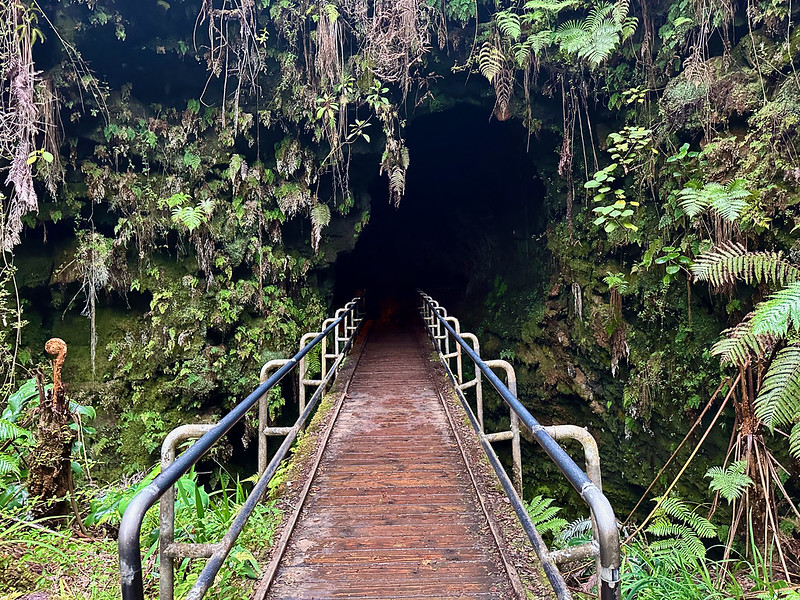Experience the Wonders of Hawaiʻi’s Nahuku Trail
Immerse yourself in the vibrant, natural beauty of Hawaiʻi Volcanoes National Park with a trek down the Nahuku Trail. This path offers an intimate encounter with native rainforest vegetation, a captivating lava tube, and striking volcanic landscapes. Nahuku Trail, also known as the Thurston Lava Tube, provides an unforgettable journey through the heart of Hawaiʻi’s geothermal wonders.
Get more Hawaiʻi Volcanoes National Park News here!
Location of Nahuku Trail in Hawaiʻi Volcanoes National Park
Nestled within the iconic Hawaiʻi Volcanoes National Park, the Nahuku Trail is situated on the Big Island of Hawaiʻi. The park itself is located in the southeast region of the island, an area known for its rich volcanic activity and diverse ecosystems. The trail is a short drive from the park’s main visitor center, making it a convenient and accessible adventure for visitors.
Getting to Nahuku Trail
By Air
The closest major airport to Hawaiʻi Volcanoes National Park is Hilo International Airport, approximately 30 miles away. Another option is the Kona International Airport, roughly 96 miles west. Both airports offer car rental services for the scenic drive to the park.
By Car
From Hilo, take Highway 11 south for about an hour, and you’ll find the park entrance on your right. If you’re coming from Kona, follow Highway 11 east, and expect a drive of just over two hours.
Best Time to Visit Nahuku Trail
Although Hawaiʻi Volcanoes National Park is open year-round, the best time to hike the Nahuku Trail is during the drier months, from April to October. During this period, the weather is generally warm and rains are less frequent, making the trail conditions more favorable. However, the park tends to be busier during this time, so early morning hikes are recommended to avoid crowds.
Other Nearby Attractions
Kīlauea Iki Trail
Just a few minutes’ drive from Nahuku Trail, the Kīlauea Iki Trail is another must-see. This 4-mile loop trail features a 400-foot elevation gain and is moderately difficult. It takes you through a lush rainforest and down to the floor of the solidified Kīlauea Iki Crater lava lake, giving you a firsthand look at the park’s volcanic activity.
Chain of Craters Road
For a less strenuous exploration, take a drive down the Chain of Craters Road. This 18-mile road descends 3,700 feet and ends where a lava flow crossed the road in 2003. It offers diverse volcanic landscapes and several scenic stops along the way.
Top Photo Spots on Nahuku Trail
The Lava Tube
One of the most memorable photo spots on the Nahuku Trail is the lava tube itself. This cave-like formation, created by flowing lava, provides a unique backdrop for dramatic and unique photos.
Rainforest Canopy
As you walk the trail, don’t miss the chance to capture the lush tropical rainforest that envelops the path. The towering ferns and native ‘ōhi’a trees provide a vibrant green landscape, especially captivating in the morning light.
Immerse yourself in the awe-inspiring environment of Hawaiʻi Volcanoes National Park with a visit to Nahuku Trail. Whether you’re a seasoned hiker or a casual nature lover, this trail offers a memorable journey through some of Hawaiʻi’s most distinctive landscapes.
Follow us on Facebook for more up-to-date National Park content!
Where to Stay
Whether you’re a seasoned camper or prefer the comfort of a cozy bed, there are plenty of lodging options both inside and near the Hawaiʻi Volcanoes National Park. Inside the park, you can enjoy a unique camping experience at the Namakanipaio and Kulanaokuaiki Campgrounds. You can reserve a spot directly through Recreation.gov.
For those who prefer a home away from home, you can find a variety of vacation rentals on AirBNB and VRBO. From rustic cabins to upscale vacation homes, there’s something to suit every taste and budget.
For a unique glamping experience, check out the yurts and upscale tents available in the region. KOA Campgrounds also offer comfortable and family-friendly camping options, which you can explore on their website.
Dining Options
While exploring the park, you’ll also find a variety of delicious dining options. The Volcano House, located near the edge of Kilauea Caldera, offers both fine dining and a more casual café. Also, the Kilauea General Store and Café Ono are local favorites for light meals and snacks.
For groceries and supplies, the Volcano Village has a selection of local grocery stores. And don’t miss the chance to try local delicacies from roadside stands and farmers markets in the surrounding region.
Travel Tips & Safety
When planning your visit, remember to pack essential gear, including sturdy shoes, rain gear, and sun protection. Stay hydrated by bringing plenty of water, especially if you’re planning to hike.
Pets are allowed in the park but must be leashed at all times and are only permitted in certain areas. Also, be aware of the potential risks of volcanic activity, such as unstable ground and harmful gases.
Check the park’s website for information about permits required for certain activities, such as backcountry hiking and camping. Always heed warnings about flash floods and altitude hazards.
Latest Park Alerts
Before you visit, it’s essential to check the official NPS alerts page for the latest information about weather, trail closures, wildfire risks, and road conditions. This can help ensure your visit is safe, enjoyable, and respectful to the park’s delicate ecosystems. Check the latest alerts here: NPS Alerts Page.
Get Involved
If you’re inspired by the beauty of Hawaiʻi Volcanoes National Park, consider getting involved with the park’s volunteer programs. Opportunities include trail work, visitor programs, and citizen science projects. Your efforts can help preserve this remarkable park for future generations. Learn more about how and where to volunteer here.
Whether you’re exploring the Nahuku Trail, camping under the stars, or sampling local cuisine, Hawaiʻi Volcanoes National Park offers an immersive and unforgettable experience. Enjoy your visit and remember to leave no trace, helping preserve the park’s beauty and biodiversity.


